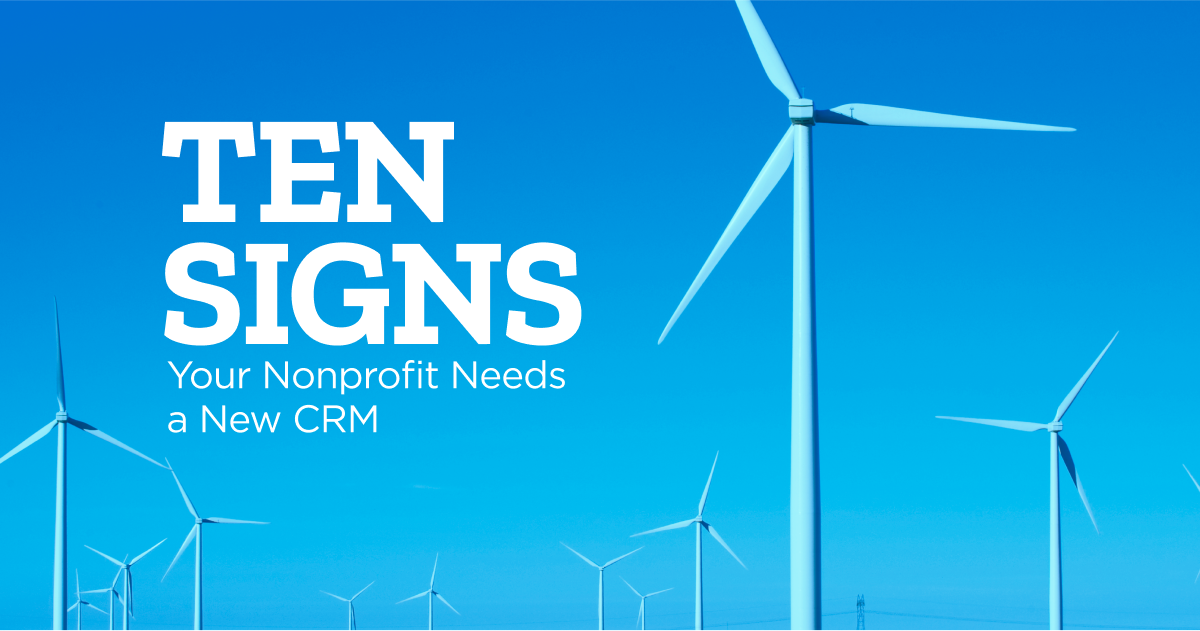Your mission is the heart of your organization. Your donors and volunteers are its lifeblood, an indispensable force that brings strength and vitality. Your customer relationship management (CRM) system is like the circulatory system, connecting you to your donors and harnessing their power to fuel your mission.
High-functioning CRM systems empower nonprofits to be more agile and responsive to donors’ interests and behaviors, leading to better outcomes for all involved. By contrast, CRM systems that are outdated, have data silos, or aren’t fully utilized can lead to inefficiencies and missed opportunities.
So, how do you know if your CRM system is healthy and fit enough to meet your organization’s needs? Here are ten signs that it’s time to upgrade your CRM.
1. You Can’t See a Complete Picture of Your Donors
Donors expect you to know who they are and understand the ways they’re connected to your nonprofit. You can lose credibility if you communicate with donors without knowing other salient details understanding their relationship with your organization.
For example, it’s difficult for major gift officers to convey competence and establish trust if they head into a visit without knowing the donor…
- Regularly gives of their time as a volunteer
- Has a long history of attending special events
- Is part of an extended family of well-known donors and supporters
- Has served in volunteer leadership positions (e.g., the board, campaign chair)
And there are other reasons for wanting to see a big-picture view of your prospects. If you don’t have a clear idea of who is engaged with and passionate about your mission, you might overlook prospects who have the ability and propensity to give or give more.
Struggling to See a Complete Picture of Your Donors?
Stop chasing the unicorn. Find out how a functional CRM can support your desire to truly understand your donors’ relationship with your organization.
2. Data Lives in Silos and is Manually Manipulated
Good data is an important asset. When you can’t see a complete picture of your donors, it’s often because departments within your organization maintain their own information.
Without the integration that a centralized CRM offers, you may notice data issues such as:
- Duplicate or lost records
- Inaccurate, incomplete, and/or outdated information
- Reconciliation discrepancies between finance and other departments
- Too much time being spent fixing inconsistencies and errors
If you or your team is manually transferring data and creating “shadow” databases in lieu of having a “sole source of truth,” that’s an indication it might be time for a new CRM.
3. Your Fundraisers Struggle to Manage Relationships Effectively
Your development team knows how to cultivate relationships with key constituents. They know how meaningful it is to remember a donor’s birthday, celebrate a career milestone, or ask how a beloved spouse, child, or pet is doing.
No matter how talented and thoughtful your development team members are, they can’t possibly remember all the details of every donor’s life on their own. They need the right data, technology, and mechanisms in place to support their good work. In other words, (and counterintuitively) effective relationship management is a data challenge.
That’s why the best fundraisers systemize their thoughtfulness.
A sophisticated nonprofit CRM can be set up to prompt team members to complete any number of action items (e.g., check in with a prospect, send a card, follow up on a proposal). This helps employees stay on top of every opportunity to propel important relationships forward.
4. Reporting is Onerous and Time Consuming
When it comes to reporting results and analyzing performance, standalone spreadsheets are not ideal.
For one, they can be incredibly time consuming to create and maintain. You may need to pull a dozen different reports and aggregate them into one spreadsheet to share your team’s progress with your executive leader or with board members.
Second, there are no rules as to what data can be entered. One slip of a finger can result in adding incorrect or otherwise faulty information that, in turn, skews results.
And finally, it can be difficult to interpret what the data in a spreadsheet is telling you. Without the ability to quickly spot trends or identify areas for improvement, it’s nearly impossible to make data-driven decisions.
By contrast, modern CRMs provide users with dynamic reports and dashboards that provide accurate insights in real time. These allow you to track metrics quickly and easily such as:
- Progress toward annual fundraising goals
- Results from specific appeals (e.g., direct mail, crowdfunding campaigns)
- How well the development team is performing compared to previous years
- Individual and team-wide middle, major, and planned gift metrics
- Special event attendance, sponsorships, and profitability statistics
A good CRM enables you to look at up to date results at the push of a button.
5. You Develop Workarounds to Accomplish Key Tasks
The goal of a CRM is to make your life easier. To that end, a functional nonprofit CRM should integrate with the other marketing, event, communication, and finance platforms you use.
Ineffective and outdated systems don’t allow you to connect to modern tools that are quickly becoming ubiquitous. If your team must create workarounds to send emails, pilot text-message campaigns, or register your supporters for events, your CRM is holding you back.
6. You Can’t Set Data-Driven Fundraising Goals
You know it’s important to make data-driven decisions, especially when it comes to setting (and reaching) fundraising goals. Even so, it’s tempting to set goals by simply striving to raise a certain percentage over last year. Or, set a target based on the gap between revenue and expenses.
To set data-driven goals, you need to have the ability to:
- Delve into historic giving data to understand your acquisition, retention, and overall growth rates
- Identify giving patterns and trends that enable you to make smart predictions
- Survey donors to learn about their giving habits and preferences
- Measure your prospective donors’ capacity and inclination to give
British mathematician Lord Kelvin said, “When you can measure what you are speaking about and express it in numbers, you know something about it; but when you cannot measure it, when you cannot express it in numbers, your knowledge is of a meager and unsatisfactory kind.”
A good CRM enables you to dig into your data, uncover untapped potential, and set measurable, quantifiable objectives.
7. You’re Spending Too Much Money to Make the System Work
Do you pay for new reports every time you want to pull new information or see it presented in a different way? Does your CRM have a ceiling in terms of how many records it can handle? Do you need to contact your vendor every time you have a new fundraising idea or initiative because you can’t pull the information you need?
These are all signs that you could save time and money with a better CRM.
8. It’s Been Three Years (or Longer) Since Your Last CRM Update
If you haven’t updated your CRM in the last few years, you’re likely missing out on significant advances in fundraising technology. Newer CRMs offer a wide range of features and functionality that can help you reach, solicit, and steward donors in a more sophisticated way.
For example, many CRMs now offer:
- Advanced segmentation and customization capabilities that allow nonprofits to target prospects in a hyper-personalized manner
- Machine learning and AI tools that can cull your database and prospect portfolios based on specified characteristics and desired behaviors
- Mobile apps that enable fundraisers and remote employees to access key information wherever they happen to be
With so much to gain, it’s clear that nonprofits using the latest generation of CRM systems have a distinct advantage.
9. Your Team Complains About the CRM
Recruiting and retaining top talent is particularly crucial to a nonprofit organization. After all, the relationships your team members steward can take years to build. And every time you rehire a key position, you can lose hard-earned momentum.
Therefore, if your team members come to you complaining that they don’t have the tools and technology they need to thrive in their role, it’s imperative that you listen.
It’s exhausting to try to do a job without the tools required to do it well. As a whole, development teams are made up of conscientious, passionate people who are driven to succeed. And quite often, they’ll do whatever it takes to get their job done—even if it means working longer hours than they should. In the long run, however, this may lead to frustration and burnout.
At the end of the day, replacing your CRM can be easier than replacing your hardworking team members. Don’t let bad technology be the reason that a good person leaves.
10. Your Nonprofit is Gearing Up for Significant Growth
If you’re a smaller nonprofit that’s raising $1 million per year from, say, a thousand donors, then your current CRM may be the right solution for you. But if you have a bold, new vision accompanied by a solid strategic plan, then your organization needs the right infrastructure on which to grow.
Wayne Gretzky said it this way: “I skate to where the puck is going to be, not where it is.”
Ask yourself: Can your current CRM help you get where you want to go? If not, it’s time to consider a new or upgraded system. To reach your growth targets and position your nonprofit to reach its full potential, you need to invest in a system that’s geared for the future, not the past.






